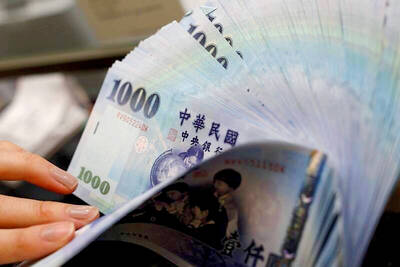Brazil, Russia, India and China flaunt their unity against more established powers this week as the four emerging economic giants hold the first summit of their grouping, known as BRIC.
But while they will express determination to act together during the current economic crisis and beyond, they are years away from being a counterbalance to established global institutions, analysts say.
It is also unclear whether Russian President Dmitry Medvedev, Chinese President Hu Jintao (胡錦濤), Brazilian President Luiz Inacio Lula da Silva and Indian Prime Minister Manmohan Singh will agree to establish a more permanent international entity.
In any case, Russia will enjoy bragging rights as host of the first formal BRIC summit, which is set to take place tomorrow in Yekaterinburg, a city 1,420km east of Moscow in the Ural Mountains.
“Russia believes this format to be rather promising economically as well as politically,” Medvedev’s spokeswoman, Natalia Timakova, told reporters this week.
But she reserved judgment on the broader implications of the summit.
“It is too early to make any predictions,” she said. “We need to see how this first meeting goes.”
Russian Foreign Ministry spokesman Andrei Nesterenko told reporters that the four leaders would adopt a joint declaration calling for the “formation of a more just and democratic world order.”
However, he could not say whether the summit would be the first in a series of regular meetings, saying it would be up to the leaders to decide.
Nesterenko also sought to quell speculation that the gathering was meant as a snub to US President Barack Obama.
“This is not a reproach to anyone,” he said.
Analysts say the BRIC nations are displaying a growing willingness to coordinate their efforts as they seek to counter US global domination and forge a bigger role for themselves.
The BRICs are expected to be major buyers of the very first bonds that the IMF is working to issue, in line with commitments by developed and developing economies to provide US$1.1 trillion to the IMF and other global bodies to help the poor.
Both Russia and China have in recent months come out in favor of revamping global financial structures, saying there was a need for a new supra-national currency to prevent a repeat of the global economic crisis.
Moscow in particular has sharply criticized the US dollar’s role as the dominant global reserve currency.
But analysts are skeptical that the BRICs can create a new reserve currency or act as a tight economic or financial entity any time soon, even as they acknowledge the importance of the group’s first gathering.
Rory MacFarquhar, a Moscow-based economist at Goldman Sachs, the investment bank credited with coining the BRIC acronym, said the significance of the summit would be political rather than economic.
“There’s considerable interest — you could say from all [the BRIC] countries but Russia in particular — in creating an alternative” to established international organizations, he said.
He said that tomorrow’s high-profile meeting would be part of the Kremlin’s “crusading against anything it considers unipolarity.”
Vladimir Osakovsky, head of strategy for UniCredit bank in Moscow, said the idea of a new reserve currency was “a politically motivated ‘news-maker’ rather than the first step towards creating a new tool of global economic policy.”
To establish the new reserve currency, Osakovsky said in a note to clients, the BRICs would have to merge their economies, abandon their own currencies and give up control over their monetary policies at home — moves they are not prepared for.
Of the major economies, powerhouse China is seen as having the best shot at eclipsing the US as the world’s largest market.
The BRIC leaders first met informally on the sidelines of a G8 major economies summit in Toyako, Japan, last year.
Tmorrow’s summit will come just after a meeting today of the Shanghai Cooperation Organization (SCO), a group dominated by Russia and China that has been described as a potential counterweight to Western-dominated bodies.
Fiercely anti-US Iranian President Mahmoud Ahmadinejad is due to attend the SCO meeting as an observer, as is Afghan President Hamid Karzai, the Russian foreign ministry said.
Yekaterinburg, where both summits are to take place, is best known as the scene of the execution of Tsar Nicolas II and his family by Bolsheviks in 1918.

Merida Industry Co (美利達) has seen signs of recovery in the US and European markets this year, as customers are gradually depleting their inventories, the bicycle maker told shareholders yesterday. Given robust growth in new orders at its Taiwanese factory, coupled with its subsidiaries’ improving performance, Merida said it remains confident about the bicycle market’s prospects and expects steady growth in its core business this year. CAUTION ON CHINA However, the company must handle the Chinese market with great caution, as sales of road bikes there have declined significantly, affecting its revenue and profitability, Merida said in a statement, adding that it would

MARKET LEADERSHIP: Investors are flocking to Nvidia, drawn by the company’s long-term fundamntals, dominant position in the AI sector, and pricing and margin power Two years after Nvidia Corp made history by becoming the first chipmaker to achieve a US$1 trillion market capitalization, an even more remarkable milestone is within its grasp: becoming the first company to reach US$4 trillion. After the emergence of China’s DeepSeek (深度求索) sent the stock plunging earlier this year and stoked concerns that outlays on artificial intelligence (AI) infrastructure were set to slow, Nvidia shares have rallied back to a record. The company’s biggest customers remain full steam ahead on spending, much of which is flowing to its computing systems. Microsoft Corp, Meta Platforms Inc, Amazon.com Inc and Alphabet Inc are

RISING: Strong exports, and life insurance companies’ efforts to manage currency risks indicates the NT dollar would eventually pass the 29 level, an expert said The New Taiwan dollar yesterday rallied to its strongest in three years amid inflows to the nation’s stock market and broad-based weakness in the US dollar. Exporter sales of the US currency and a repatriation of funds from local asset managers also played a role, said two traders, who asked not to be identified as they were not authorized to speak publicly. State-owned banks were seen buying the greenback yesterday, but only at a moderate scale, the traders said. The local currency gained 0.77 percent, outperforming almost all of its Asian peers, to close at NT$29.165 per US dollar in Taipei trading yesterday. The

The US overtaking China as Taiwan’s top export destination could boost industrial development and wage growth, given the US is a high-income economy, an economist said yesterday. However, Taiwan still needs to diversify its export markets due to the unpredictability of US President Donald Trump’s administration, said Chiou Jiunn-rong (邱俊榮), an economics professor at National Central University. Taiwan’s exports soared to a record US$51.74 billion last month, driven by strong demand for artificial intelligence (AI) products and continued orders, with information and communication technology (ICT) and audio/video products leading all sectors. The US reclaimed its position as Taiwan’s top export market, accounting for